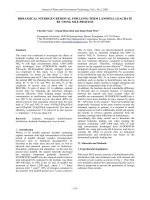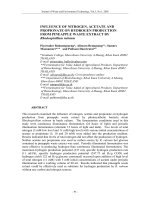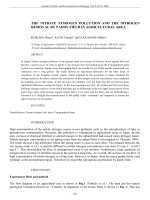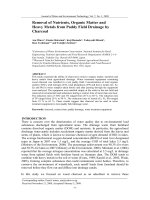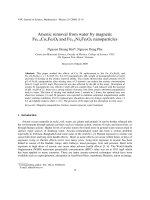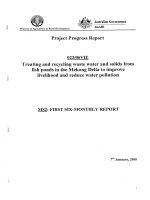NITROGEN REMOVAL FROM FISH FARMS WATER BY lemna minor AND wolffia arrhiza
Bạn đang xem bản rút gọn của tài liệu. Xem và tải ngay bản đầy đủ của tài liệu tại đây (474.17 KB, 6 trang )
Proceedings of ECOpole
DOI: 10.2429/proc.2016.10(1)052
2016;10(2)
Larisa SABLIY1, Sergiy KONONTSEV1, Juliya GROKHOVSKA2
Marcin K. WIDOMSKI3 and Grzegorz ŁAGÓD3
NITROGEN REMOVAL FROM FISH FARMS WATER
BY Lemna minor AND Wolffia arrhiza
USUWANIE AZOTU Z WODY GOSPODARSTW RYBNYCH
Z WYKORZYSTANIEM RZĘSY DROBNEJ I WOLFII BEZKORZENIOWEJ
Abstract: It is extremely important for the productive fish farming with closed water systems to treat the water to
the level allowing its reuse for fish production. This paper presents studies considering the possibility of water
embryophyte application to assimilation of pollutants (mainly nitrogen compounds) solute in water of recirculation
systems in fish farms. The results of experimental studies covering ammonium nitrogen removal from polluted
water of fish farms by the tested Lemnoideae representatives (Lemna minor and Wolffia arrhiza) were presented.
The obtained results confirmed the usefulness of phytoreactors application in wastewater treatment plants in fish
farms.
Keywords: pollution of water in fish farms, nitrogen removal, Lemnoideae in water treatment
Introduction
The general tendency of decrease in aquatic resources resulting in decreased fishing,
numbers and diversity of fish as well as amount of fishless water reservoirs in the
environment stimulates the development of aquaculture in the artificial water reservoirs,
especially a fishing farms utilizing re-use of water (RAS, Recirculation Aquaculture
Systems). Ukraine may be characterized by relatively low volumes of industrial fish
breeding which is related to the general unsatisfactory state of economy and production in
the country as well as the general archaic attitude towards fish farming [1, 2]. But on the
other hand, problems related to fish and seafood import, caused by money devaluation,
stimulate the development of domestic production and justify the advisability of creation of
the highly-productive fish farms based on the modern technologies of production.
The successful fish production in RAS requires the proper living and feeding
conditions [3, 4], so the main factors influencing the farming efficiency are composition
and amount of feed and characteristics of water reservoir - the quality of water available for
fish farming and effectivity of its treatment for possible re-use. Thus, omitting the
economic factors and availability of water sources, the main problem of RAS is the quality
of aquatic environment for fish farming - assuring treatment for water allowing its reuse.
The main tasks of RAS’ treatment plants is removal of solute and non-reconstituted
nutrients, especially ammonium and phosphates [5-7]. In order to remove the undissolved
pollutants the mechanical filters are used. Removal of solute pollutants and the fine-grained
dispersed phase, which is unable to be filtered, is performed due to application of biological
1
Chair of Ecobiotechnology and Bioenergy, National Technical University of Ukraine “Igor Sikorsky Kyiv
Polytechnic Institute”, Peremogy Ave 37, 03056 Kyiv, Ukraine
2
National University of Water Management and Nature Resources Use, Soborna st., 11, 33000 Rivne, Ukraine
3
Faculty of Environmental Engineering, Lublin University of Technology, ul. Nadbystrzycka 40B, 20-618 Lublin,
Poland, phone +48 81 538 44 81, email: ,
Contribution was presented during ECOpole’16 Conference, Zakopane, 5-8.10.2016
500
Larisa Sabliy, Sergiy Konontsev, Juliya Grokhovska, Marcin K. Widomski and Grzegorz Łagód
methods of treatment [8-10]. Concentration of nitrogen compounds may be treated as the
main indicator for water treatment quality assessment in RAS because most of the
pollutants is available as ammonium nitrogen [11].
Biotechnologies allowing transformation of nitrogen compounds due to bacterial
microflora (by nitrification and denitrification) present several negative issues for RAS.
The most important are: required considerable amounts of nitrificators and denitrificators
for bioreactors, necessity of the outside carbon sources (e.g. methanol) for denitrification
and required stabilization of water parameters [5, 8, 9, 11-15]. The application of
embryophyte is more perspective manner of nitrogen removal from water in fish farms
[16-19]. There are known several advantages of such treatment, as related to the processes
using nitrobacteria: resistance to higher concentrations of nitrogen compounds, direct
assimilation of ammonium nitrogen without the intermediate processes and high ratio of
metabolism in favourable process conditions [17, 18, 20].
The experience with embryophyte application to RAS water treatment was gained by
European and Asian countries. In our opinion, in case of Ukrainian conditions, the
application of the freely floating plants to RAS water treatment may be quite effective.
Validity of embryophyte application in order to restore the required quality of water in RAS
is justified by typical characteristics of fish farming in artificial and controlled aquatic
ecosystems. The ability of plants to consume nutrients may be assessed basing on their
composition and dynamics of biomass growth. The assurance of the optimal farming
conditions, including the proper lighting and the optimal temperature for given species, is
the important condition for the maximum growth ratio of plants. So, it is important to
utilize plants characterized by the rapid growth and capable to adjust to artificial conditions
of farming.
Thus, the aim of presented research covered determination of possible application of
Lemnoideae (Lemna minor and Wolffia arrhiza) to breeding water treatment in fish farms
of water closed circuit.
Materials and methods
The experiments of Lemnoideae cultivation included in this paper were performed
during 10 weeks in tilapia (Oreochromis aureus) fish farm and under the laboratory
conditions. The cultivation was located in phytoreactor integrated with the unit of biologic
treatment of wastewater from the fish farm. The dimensions of the reactor were
130х55х40 cm. Two lamps of 36 W of power each were applied as lighting devices. The
time duration of water detention in the device was equal to 35-40 min.
During the parallel experiment under the laboratory conditions the reservoirs of 45 dm3
volume operating in the sequential layout were used. The untreated water from RAS after
Oreochromis ureus and Clarias gariepinus breeding was used. The laboratory setup was
not additionally illumed. The cultures of studied plants Lemna minor L. and Wolffia arrhiza
(L.) Horkel ex Wimm developed under the artificial conditions were dosed into all tested
volumes. The weighing of raw plants’ mass was performed daily using electronic scale
ТВЕ (0.21-0.001 accuracy EN ISO 45501-2) with 0.001 h of error. Ammonium, nitrites
an nitrates content were determined by the laboratory ion meter I-160-M equipped with the
ion selective membrane electrodes.
Nitrogen removal from fish farms water by Lemna minor and Wolffia arrhiza
501
Results
The results of our studies confirmed the rapid increase in biomass of Lemnoideae
under the favourable conditions (which can be created) in phytoreactor for treatment of
wastewater RAS (Fig. 1). Lemna minor and Wolffia arrhiza placed in the flow reservoirs
increased their mass approx. twice (88-110%) during 24 hours.
Fig. 1. Dynamics of Lemnoideae growth under conditions of flow phytoreactor
The studied species were resistant to presence of different forms of nitrogen in water.
In one of the tested samples the noted concentration of ammonia was equal to 32 mg/dm3,
while usually the ammonium concentration in samples at the outflow from the reservoirs of
fish farming was 0.6-2.8 mg/dm3. The range of presented concentrations is acceptable for
most of floating plants, especially Lemnoideae. Thus, no problems related to their
cultivation under the flow and stationary conditions were noted. The predicted ratio of
plants growth was unchanged, which was related to the constant concentration of pollutants
at the inflow from farming tanks.
The parallel series of experiments under the stationary conditions was performed in
volume of 45 dm3 reservoirs of bioreactors. The initial concentrations of ammonia nitrogen
at the inflow to bioreactor was 30-32 mg/dm3, while nitrates and nitrites were observed in
the lower concentrations (0.8 and 11.5 mg/dm3, respectively).
During the experiment four technological lines were used, two of them were used as
the frame of reference - one without aeration, the second one intensively aerated by the air
compressor. The remaining two were used to determine the dynamics of nitrogen removal
by Lemna minor and Wolffia arrhiza (Fig. 2).
The presented results confirmed the possibility of partial ammonia nitrogen removal
due to intensive aeration of the tank. It was also observed that the high concentration of
ammonia nitrogen in water had no negative influence on living conditions and plants
biomass increase.
Larisa Sabliy, Sergiy Konontsev, Juliya Grokhovska, Marcin K. Widomski and Grzegorz Łagód
ammonia nitrogen concentration [mg/dm3]
502
Control
Aeration
Wolffia arrhiza
Lemna minor
time [h]
Fig. 2. Changes of ammonia nitrogen concentration in static conditions
Only the partially decrease in nitrate concentration in the aerated samples was
observed. Generally, aeration allowed to reduce ammonia nitrogen concentration for
approx. 50%. Despite the positive effect of reduction of ammonia concentration in water,
the intensive aeration may present some serious disadvantages, including the considerable
energy consumption and changes in heat balance. Moreover, in order to ensure the process
operation, the usage of appropriate devices (air compressors, fittings, valves and pipelines)
is required. The increase of ammonia nitrogen in unaerated sample, by approx. 2.5 mg/dm3
after 48 hours may be explained by transformation of fine grained pollutants into the solute
phase. Under the conditions of RAS water treatment for which the efficiency of dispersed
phase removal no filters may reach the level of 45-80%, the fine suspended phase is usually
present.
Determination of water treatment efficiency (as related to ammonia nitrogen presence)
of the phytoreactor with aquatic embryophyte may be performed basing on the results of
the presented experiment an theoretical data concerning morphology and biochemistry of
plants. According to the experimental studies 1 g of Lemna minor and Wolffia arrhiza is
capable to remove from 2.6 to 6.0 mg NH4+ per day, under the conditions of the bright daily
light, without artificial illumination. Basing on the data concerning nitrogen content in dry
mass of plants, in range of 4.2-6% (at water content in the plants reaching the level of 90%)
and possibility to double its mass during time of 1-2 days, it may be assumed that daily
nitrogen assimilation capability may reach the level of 2-6 g per 1 kg of raw mass, which
reflects 1.64-4.94 g of ammonium. The obtained experimental data proved the theoretical
calculations. However it should be noted that maximum possible capability of nitrogen
assimilation may be obtained only at favorable temperature (24-30°C) and under the
required light as well as presence of macro- and microelements.
Nitrogen removal from fish farms water by Lemna minor and Wolffia arrhiza
503
Summary and conclusions
The tested plant species Lemna minor and Wolffia arrhiza showed good
accommodation to the conditions of flow phytoreactor used in RAS waste water treatment.
The experimental studies concerning Lemnoideae cultivation in phytoreactor treating
circulating RAS water confirmed the high capability of these plants in ammonium nitrogen
removal. The ability of ammonia ion assimilation may vary in a quite wide range and
results from the conditions of the specific phytoreactor. But it may be approximated
as 2 g NH4+ daily for 1 kg of raw mass.
The efficiency of phytoreactor in ammonia nitrogen assimilation may be highly
dependent to biomass of the cultivated plants (as a process factor). But the settlement
density of several types of Lemnoideae inside the phytoreactor is limited by their biological
characteristics. Under the artificial conditions, with the intense artificial illumination, the
settlement density of Lemna minor and Wolffia arrhiza may reach the value of 5-8 kg per
1 m2. So, the ammonium assimilation capability of Lemnoideae phytoreactor may reach the
level of 16 g NH4+ daily at the area of 1 m2 of the device.
Determination of the boundary load of the tested water treatment may be performer by
the experimental method - measurement of main pollutants concentration before and after
the treatment, as well as the theoretical one - using recommendations for loads proportional
to amount and quality of applied feed. However, the results of theoretical determination
may be only treated as preliminary and approximate. To remove the solute pollutants
introduced to water with the 1 kg of dosed feed containing 40% of proteins, 10-20 kg of
raw plants mass are required, corresponding to the area of phytoreactor equal to 0.7-2 m2.
References
[1]
[2]
State Statistic Committee of Ukraine, .
FAO FishStatJ - Universal software for fishery statistical time series. />statistics/software/fishstatj/ru.
[3] Lochmann R, Engle C, Kumar G, Li MH, Avery JL, Bosworth BG, et al. Multi-batch catfish production and
economic analysis using alternative (low-cost) diets with corn gluten feed and traditional diets with meat and
bone meal. Aquaculture. 2012;366:34-39. DOI: 10.1016/j.aquaculture.2012.08.052.
[4] Meriac A, Eding EH, Schrama J, Kamstra A, Verreth JAJ. Dietary carbohydrate composition can change
waste production and biofilter load in recirculating aquaculture systems. Aquaculture. 2014;420:254-261.
DOI: 10.1016/j.aquaculture.2013.11.018.
[5] Martins CIM, Eding EH, Verdegem MCJ, Heinsbroeka LTN, Schneider O, Blanchetond JP, et al. New
developments in recirculating aquaculture systems in Europe: A perspective on environmental sustainability.
Aquac Eng. 2010;43(3):83-93. DOI: 10.1016/j.aquaeng.2010.09.002.
[6] Schneider O, Sereti V, Eding EH, Verreth JAJ. Analysis of nutrient flows in integrated intensive aquaculture
systems. Aquac Eng. 2005;32(3-4):379-401. DOI: 10.1016/j.aquaeng.2004.09.001.
[7] Piedrahita RH. Reducing the potential environmental impact of tank aquaculture effluents through
intensification and recirculation. Aquaculture. 2003;226(1-4):35-44. DOI: 10.1016/S0044-8486(03)00465-4.
[8] Abeysinghe DH, Shanableh A, Rigden B. Biofilters for water reuse in aquaculture. Water Sci Technol.
1996;34(11):253-260. DOI: 10.1016/S0273-1223(96)00845-1.
[9] vanRijn J, Rivera G. Aerobic and anaerobic biofiltration in an aquaculture unit-nitrite accumulation
as a result of nitrification and denitrification. Aquac Eng. 1990;9(4):217-234. DOI:
10.1016/0144-8609(90)90017-T.
[10] Crab R, Avnimelech Y, Defoirdt T, Bossier P, Verstraete W. Nitrogen removal techniques in aquaculture for
a sustainable production. Aquaculture. 2007;270(1-4):1-14. DOI: 10.1016/j.aquaculture.2007.05.006.
[11] Kelly LA, Bergheim A, Hennessy MM. Predicting output of ammonium from fish farms. Water Res.
1994;28(6):1403-1405. DOI: 10.1016/0043-1354(94)90307-7.
504
Larisa Sabliy, Sergiy Konontsev, Juliya Grokhovska, Marcin K. Widomski and Grzegorz Łagód
[12] Lee PG, Lea RN, Dohmann E, Prebilsky W, Turk PE, Ying H, et al. Denitrification in aquaculture systems:
an example of fuzzy logic control problem. Aquac Eng. 2000;23(1-3):37-59. DOI:
10.1016/S0144-8609(00)00046-7.
[13] Tsukuda S, Christianson L, Kolb A, Saito K, Summerfelt S. Heterotrophic denitrification of aquaculture
effluent using fluidized sand biofilters. Aquac Eng. 2015;64:49-59. DOI: 10.1016/j.aquaeng.2014.10.010.
[14] van Rijn J, Tal Y, Schreier HJ. Denitrification in recirculating systems: Theory and applications. Aquac Eng.
2006;34(3)364-376. DOI: 10.1016/j.aquaeng.2005.04.004.
[15] Villaverde S, Fdz-Polanco F, García PA. Nitrifying biofilm acclimation to free ammonia in submerged
biofilters, Start-up influence. Water Res. 2000;34(2): 602-610. DOI: 10.1016/S0043-1354(99)00175-X.
[16] Mohedano RA, Costa RHR, Tavares FA, Filho PB. High nutrient removal rate from swine wastes and
protein biomass production by full-scale duckweed ponds. Biores Tech. 2012;112: 98-104. DOI:
10.1016/j.biortech.2012.02.083.
[17] Culley DD, Rejmankova E, Kvet J, Frye JB. Production, chemical quality and use of duckweeds
(Lemnaceae) in aquaculture, waste management, and animal feeds. J World Aquac Soc. 1981;12(2):27-49.
DOI: 10.1111/j.1749-7345.1981.tb00273.x.
[18] Skillicorn P, Spira W, Journey W. Duckweed aquaculture: a new aquatic farming system for developing
countries. Washington, DC: The World Bank. Documents & Reports; 1993. .
[19] Sindilariu PD, Brinker A, Reiter R. Factors influencing the efficiency of constructed wetlands used for the
treatment
of
intensive
trout
farm
effluent.
Ecol
Eng.
2009;35(5):711-722.
DOI:
10.1016/j.ecoleng.2008.11.007.
[20] Naylor S, Brisson J, Labelle MA, Drizo A, Comeau Y. 2003. Treatment of freshwater fish farm effluent
using constructed wetlands: the role of plants and substrate. Water Sci Technol. 2003;48(5):215-222.
USUWANIE AZOTU Z WODY GOSPODARSTW RYBNYCH
Z WYKORZYSTANIEM RZĘSY DROBNEJ I WOLFII BEZKORZENIOWEJ
1
Narodowy Techniczny Uniwersytet Ukrainy „Kijowski Politechniczny Instytut
im. Igora Sikorskiego - IS KPI”, Kijów, Ukraina
2
Państwowy Uniwersytet Gospodarki Wodnej i Wykorzystania Zasobów Przyrody, Równe, Ukraina
3
Politechnika Lubelska, Lublin, Polska
Abstrakt: Dla wydajnej hodowli ryb w układach z zamkniętym systemem obiegu wodnego niezwykle ważne jest
właściwe oczyszczanie wody do poziomu, który pozwala na jej ponowne wykorzystanie. W opracowaniu
przedstawiono możliwość zastosowania wyższych roślin wodnych do asymilacji zanieczyszczeń rozpuszczonych
w wodzie, głównie związków azotu. Zaprezentowane wyniki badań eksperymentalnych dotyczą usuwania azotu
amonowego z zanieczyszczonej wody gospodarstw rybnych przedstawicielami rzęsowych (Lemnoideae) rzęsą
drobną i wolfią bezkorzeniową. Wyniki te potwierdzają zasadność wykorzystania fitoreaktorów w obiektach
oczyszczalni gospodarstw hodowli ryb.
Słowa kluczowe: zanieczyszczenia wody gospodarstw rybnych, usuwanie azotu, Lemnoideae w oczyszczaniu
wody
